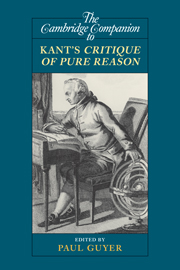Book contents
- Frontmatter
- Introduction
- Part I The Background to the Critique
- Part II The Arguments of the Critique
- 3 The Introduction to the Critique: Framing the Question
- 4 The Transcendental Aesthetic
- 5 The Deduction of the Categories: The Metaphysical and Transcendental Deductions
- 6 The System of Principles
- 7 The Refutation of Idealism and the Distinction between Phenomena and Noumena
- 8 The Ideas of Pure Reason
- 9 The Paralogisms of Pure Reason
- 10 The Antinomies of Pure Reason
- 11 The Ideal of Pure Reason
- 12 The Appendix to the Dialectic and the Canon of Pure Reason: The Positive Role of Reason
- 13 The Transcendental Doctrine of Method
- Part III The Impact of the Critique
- Bibliography
- Index
4 - The Transcendental Aesthetic
from Part II - The Arguments of the Critique
Published online by Cambridge University Press: 28 July 2010
- Frontmatter
- Introduction
- Part I The Background to the Critique
- Part II The Arguments of the Critique
- 3 The Introduction to the Critique: Framing the Question
- 4 The Transcendental Aesthetic
- 5 The Deduction of the Categories: The Metaphysical and Transcendental Deductions
- 6 The System of Principles
- 7 The Refutation of Idealism and the Distinction between Phenomena and Noumena
- 8 The Ideas of Pure Reason
- 9 The Paralogisms of Pure Reason
- 10 The Antinomies of Pure Reason
- 11 The Ideal of Pure Reason
- 12 The Appendix to the Dialectic and the Canon of Pure Reason: The Positive Role of Reason
- 13 The Transcendental Doctrine of Method
- Part III The Impact of the Critique
- Bibliography
- Index
Summary
Kant's Critique of Pure Reason is divided into two sections, the “Transcendental Doctrine of Elements” and the “Transcendental Doctrine of Method”, the former of which is further divided into two parts, the “Transcendental Aesthetic” and the “Transcendental Logic.” Although it is comparatively very short, the Transcendental Aesthetic is a crucially important component of Kant's work, its stated aim being to present a “science of all principles of a priori sensibility” (A 21/B 35). Here, Kant articulates a theory of pure sensible intuition, and deploys arguments in support of the transcendental ideality of space and time. Taken together, the Transcendental Aesthetic and the Transcendental Logic (“which contains the principles of pure thinking”) are meant to provide an account of human cognition and judgment according to which sensibility and understanding - our capacities for being affected by and for thinking about objects, respectively - each play ineliminable roles. In what follows, I will identify and explain the terminology that Kant introduces in the Aesthetic; present and discuss the arguments Kant offers in the Metaphysical and Transcendental Expositions of Space and Time; and show how (and why) Kant concludes from these “expositions” that space and time are transcendentally ideal.
- Type
- Chapter
- Information
- The Cambridge Companion to Kant's Critique of Pure Reason , pp. 93 - 117Publisher: Cambridge University PressPrint publication year: 2010
- 5
- Cited by



